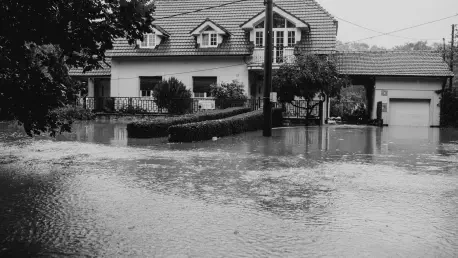Homeowners across the United States increasingly face a new frontier as the steady evolution of climate change imposes unprecedented challenges on the insurance industry. Traditionally, homeowners insurance provided a safety net against unforeseen events, but the increase in climate-related risks has begun to strain this framework. Natural disasters are more frequent and severe, compelling insurers to reevaluate their risk capacities. In this rapidly shifting landscape, understanding these dynamics is essential. Discussions center on the interplay between escalating climate risks, essential economic considerations, the evolving regulatory environment, and emerging trends within the insurance industry. For homeowners, one burning question remains: how to navigate a world where obtaining and maintaining adequate insurance coverage grows more fraught with each passing year? The answers to these questions could offer a lifeline to policyholders worried about their financial security in the face of an unpredictable climate future.
Climate-Induced Disruptions
The palpable rise in climate-related phenomena such as wildfires, hurricanes, and floods is reshaping expectations for environmental and financial stability. These events are not just occurring more frequently; their intensity has also grown. This escalation places significant pressure on the insurance industry, which is grappling with record levels of claims as damages mount. Insurers might respond to these challenges by increasing premiums or even withdrawing from high-risk markets entirely. In places like California, for instance, wildfires have decimated entire communities, prompting some major insurers to curtail their involvement, given the unsustainable financial losses they face. The risk assessment frameworks employed in previous decades are proving inadequate against the backdrop of today’s climate realities. Insurers must consider not only historical data but also predictive models that factor in future climate scenarios. For homeowners, this translates into an urgency to understand their geographical risk profile and pursue proactive measures to reinforce their property’s resilience against these threats.
Homeowners in vulnerable areas are experiencing a tangible shift in how insurance coverage is structured and priced. Areas previously deemed safe may now encounter reevaluation schedules, changing the landscape of insurability. For consumers, this means potential increases in policy costs or alternative eviction notices by insurers seeking to limit risk exposure. Some regions, once considered low to medium risk, are increasingly categorized under higher risk brackets. This has severe implications not only for the insurance industry but also for property values and the broader real estate market. As the frequency of climate-related disasters continues to rise, the cumulative effect on both property desirability and insurability becomes more pronounced. The emerging reality necessitates homeowners to stay informed and possibly reassess investment and maintenance strategies to bolster their asset’s value and attractiveness to insurers.
Strains of Economic Pressure
Beyond the damages wrought by climate events, economic factors exert their measure of stress on homeowners and insurers alike. The rising cost of materials and labor required for reconstruction post-disaster is an area of significant concern. This inflationary trend is making it arduous for insurance providers to effectively cover claims without passing on some of these costs to policyholders. Homeowners are consequently facing steeper premiums over time, which could lead in some cases to the painful decision of foregoing insurance entirely. This lies in stark contrast to the notion that insurance acts as a financial buffer in case of emergency. Meanwhile, increased repair costs contribute to the extended periods some properties remain in disrepair following disaster strikes, exacerbating potential subsequent damages. For both insurers and homeowners, these economic realities demand reassessment of financial strategies aimed at optimizing disaster preparedness and response.
Insurers also face an uptick in the frequency and severity of claims, a trend that threatens the feasibility of maintaining operations in some jurisdictions. This rise in claims correlates with the increasingly volatile climate conditions. As businesses, insurers must weigh risks and returns, which means that when particular areas show unsustainable loss patterns, the logical but perhaps unpopular decision may be to cease offering coverage there. This consequence illustrates the interconnected nature of climate challenges and economic operations. It’s not merely about rising costs but also sustaining a viable business model in an unpredictable environment. For homeowners, recognizing this complex interplay and planning ahead becomes essential. Constructing strategic, well-informed financial plans is crucial to securing property against impending natural and fiscal uncertainties.
Regulatory Restrictions and Considerations
The regulatory landscape governing homeowners insurance plays a pivotal role in shaping industry response to climate change. State-level legislation aimed at consumer protection, such as California’s Proposition 103, restricts insurers’ abilities to hike rates to match elevated risk levels. While well-intentioned, such policies may inadvertently encourage insurers to withdraw from high-risk zones, as they might struggle to balance consumer protection with business sustainability. Limiting rate hikes could lead insurers to minimize risks by simply offering fewer policies in areas with heightened threat levels. Another manifestation of these regulatory constraints is a shift towards government-supported insurance solutions like FAIR plans. These plans tend to provide basic coverage at a higher cost, acting as a fallback for those unable to secure private insurance. However, the trade-off for homeowners often involves accepting higher premiums and reduced protection scope, underscoring the challenge of regulating risk distribution equitably in an increasingly unpredictable climate paradigm.
The intricate dance between regulatory bodies and insurers is central to understanding how insurance markets function under stress. State governments need to strike a balance between safeguarding consumer interests and allowing insurers sufficient leeway to adapt to emerging risks economically. In regions where the risks are uninsurable under private policies, policymakers are experimenting with public-private partnerships to provide a safety net. These initiatives often act as supplements to private insurance, attempting to deliver comprehensive coverage despite overwhelming environmental threats. The balance between maintaining market viability and ensuring consumer protection continues to test the creativity and resolve of regulatory authorities and industry participants alike.
Navigating New Industry Trends
Emerging trends within the insurance industry paint a picture of a rapidly transforming landscape with adaptability at its core. Insurers are rethinking traditional approaches in favor of technologically enabled solutions, such as advanced predictive analytics and satellite imagery, to assess and mitigate risks more effectively. Integrating innovative technologies into insurance risk management supports more precise underwriting, ultimately benefiting both insurers and policyholders. For policyholders, understanding these advancements and how they influence coverage decisions could play a crucial role in maintaining insurability and managing costs. Additionally, there is a noticeable thrust towards encouraging policyholders to adopt protective measures, with incentives such as premium discounts for those implementing mitigation strategies like wildfire hardening and flood defenses.
Nationwide, a discernible pattern of tightening eligibility criteria and stricter claim scrutiny is taking hold. Homeowners need to pay close attention to the policy fine print, as denial rates for claims have been on the rise. Insurers, pressured by unsustainable loss patterns, are exercising greater diligence in claims processing. For consumers, this means embracing a proactive approach that includes documenting property conditions regularly and communicating transparently with insurers. Keeping a home well-maintained lessens the probability of non-renewal stemming from neglected disrepair. The industry is signaling its preference for cooperating with informed, engaged policyholders willing to take shared responsibility for risk management. As insurers evolve, remaining attuned to these shifts and responding aptly could alleviate some of the hurdles anticipated in the future insurance landscape.
Strategic Steps for Homeowners
For homeowners contending with these extensive developments, strategic planning emerges as imperative. Upon receiving notice of cancellation or non-renewal, it is prudent to delve into the reasons behind such decisions. Engaging immediately with the insurance provider creates an opportunity to explore options or rectify misunderstandings. Shopping around for alternate coverage can also yield beneficial results, particularly when assisted by independent insurance agents offering a comprehensive view of market options. These agents can provide invaluable guidance in identifying alternative providers willing to underwrite policies at competitive rates. Another crucial element lies in proactive management of property maintenance. Routine checks and fixes not only safeguard against potential damages but also demonstrate due diligence to insurers assessing risk profiles.
Considering state-supported options like FAIR plans might become necessary when traditional policies remain elusive. However, this should be a measure of last resort due to the inherent limitations these plans present regarding cost and coverage comprehensiveness. Homeowners can also seek to invest in resiliency measures, as taking steps toward fortifying their properties against climate risks including stormproofing and fire-resistant materials might attract favorable insurance terms. Honesty and accuracy in policy applications are fundamental, as discrepancies can lead to complications during claim processing or even policy cancellation. Collectively, these actions fortify a homeowner’s position within the insurance marketplace, providing a more secure platform for facing the formidable array of currently anticipated challenges.
Future Insurance Landscape Implications
Homeowners throughout the United States are encountering uncharted territory as climate change continuously transforms and challenges the insurance sector. In the past, homeowners insurance acted as a buffer against unexpected events. However, the rise in climate-related threats, such as more frequent and intense natural disasters, is testing this safety net. Insurers are now forced to reassess their risk management strategies. In this dynamic climate, grasping these shifts is crucial. The dialogue revolves around the delicate balance between surging climate risks, vital economic factors, the shifting regulatory landscape, and new patterns in the insurance sector. For homeowners, the pressing issue remains: how to secure and retain sufficient insurance coverage as it becomes increasingly difficult each year? Unraveling these questions could provide a lifeline to those policyholders who fear for their financial stability amid a changing and unpredictable climate landscape, offering solutions to strengthen their peace of mind in an unsure future.









